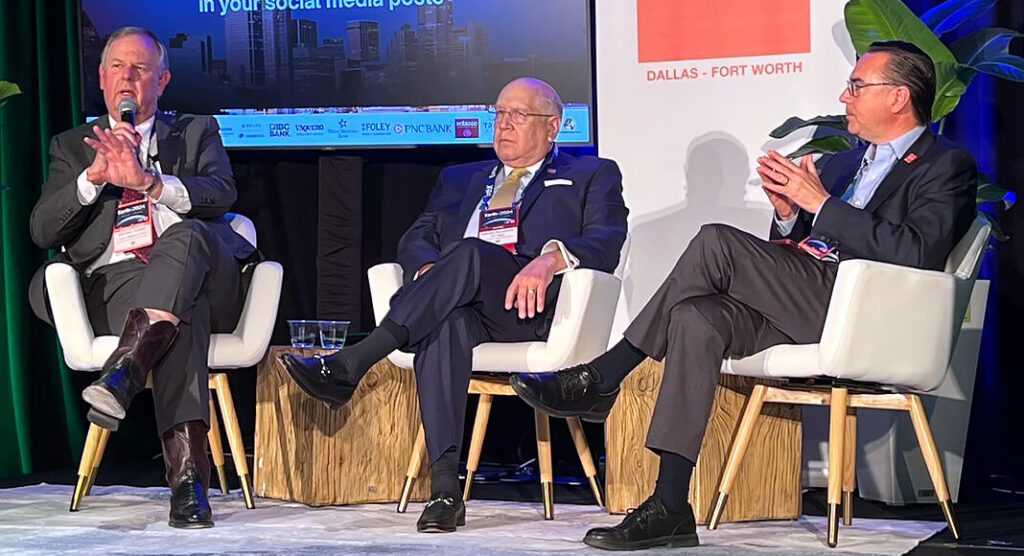
Texas Border Business
By Roberto Hugo González
Nearshoring in 2024 was at the forefront of discussion at the Texas-México Business Summit, hosted by La Asociación de Empresarios Mexicanos DFW Chapter (AEM) at the Hilton Anatole Hotel in Dallas. One of the event’s highlights was a panel discussion titled “Shaping the Future: Financial Services and Nearshoring Insights,” featuring; Gerald Schwebel Executive Vice President of the Corporate International Division at International Bank of Commerce, and Michael Scaief, Chairman of the Board and CEO of Texas Regional Bank.

The panel explored the region’s dynamics of nearshoring, cross-border trade, and financial services. Scaief emphasized the cyclical nature of economic relations between the U.S. and Mexico, and when asked for his perspective on working within a binational framework, he noted that the CEOs of companies involved in these transactions are “dealing with the company’s risks and producing profits” daily. Scaief traced the historical context of nearshoring back to the 1980s, recalling the “twin plants” era operating under the maquiladora model along the U.S.-Mexico border. The rise of globalization in the 1990s and 2000s shifted production to China, but recent global disruptions have prompted businesses to reconsider Mexico.
“What happened during that period when China gained a foothold in the economy and manufacturing moved overseas? What disruption occurred then, and what’s happening now to bring it back?” Scaief asked. He pointed to global disruptions like the COVID-19 pandemic, geopolitical tensions, and supply chain vulnerabilities as catalysts driving the nearshoring trend.

Managing Risk and Certainty
Scaief emphasized the importance of risk management and certainty in cross-border financing: “So, I talked a minute ago about the eighties and Reagan and his decisions to allow nearshoring. Well, that was all about certainty. It’s all about ensuring the supply chain was next door so we could get there without disruption.”
The certainty of proximity, reduced shipping times, and stable supply chains have made nearshoring increasingly attractive to businesses.
Banking Models: Mexico vs. U.S.
Scaief compared the banking models of Mexico and the U.S., highlighting key differences in financial ratios:
• Return on Equity (ROE): ”Mexican banks have an average ROE of 18%, while U.S. banks’ ROE is about 12%.”
• Net Interest Margin (NIM): ”Mexican banks’ NIM is around 7%, compared to 3.25% for U.S. banks.”
• Past-Due Ratios: ”Mexican banks have an average past-due ratio of 3%, whereas it’s about 0.5% for U.S. banks.”
Scaief stressed the importance of cross-border financing in fostering trade and investment between the two countries while noting the challenges in aligning financial models and regulatory frameworks. “We’re interested in disruption, risk, and certainty,” he said, urging businesses to leverage nearshoring opportunities by managing these risks.
He further explained the role of risk and certainty in cross-border financing: ”The charge-off ratio for Mexican banks is 3%, compared to 0.5% for U.S. banks. This highlights the importance of risk and certainty.”
Establishing certainty is crucial for effective binational financing, ensuring access to collateral or returns. Scaief identified two primary ways to fund business growth: earnings and borrowings.
“If we’re taking debt to Mexico, we must ensure its recoverability. On the U.S. side, this certainty leads to much lower margins.”
He concluded with a comparison of financial insights:
• Net Income: ”Net income for U.S. banks averages 1% of assets, while for Mexican banks it’s 2%, effectively double.”
• Net Interest Margin (NIM): ”Mexican banks’ NIM is 7%, while U.S. banks’ NIM is 3.25%.”
• Past-Due Ratios: ”Mexican banks have a 3% past-due ratio, compared to 0.5% for U.S. banks.”
Scaief addressed the impact of political, social, and economic risks on cross-border financing, emphasizing the need for public-private partnerships: ”Our business would go broke trying to change the world, but what we do is create private-public partnerships that help bring people together. Our economic development division collaborates with private businesses and the public sector.”
He acknowledged that regulation, despite its challenges, creates opportunities for innovation: “Regulation creates a barrier to entry. As hard as this is to say, it creates an opportunity for you to find a way to do something better than the other person.”
Using the housing industry as an example, he illustrated how a lack of regulation leads to saturation and reduced profitability.
Scaief emphasized the importance of strong teams to facilitate cross-border financing: ”You need attorneys, accountants, and a counterparty. If you’re from Mexico, you need a U.S. counterparty. If you’re from the U.S., you need a Mexican counterparty.”
Government-backed guarantees and SME Financing
A question from the audience highlighted the importance of government-backed guarantees for reducing the risk of financing small and medium-sized enterprises (SMEs). Dismantling the national guarantee system had negatively affected SME financing in Mexico, leading to a 33% drop in lending after financing 720 billion pesos in six years.
Scaief acknowledged the importance of such programs but emphasized that political and social risks still affect lending: ”The guaranteed trust is what most banks use today to help with certainty and control that asset. It gives us ownership but doesn’t protect you from political or social risks.”
Sergio Seañes, leader of the Nearshoring Task Force at the U.S.-Mexico Business Association, pointed out that financing alone is not enough for SMEs to compete with larger companies like Tesla or GM.
“For Tesla, GM, and Ford, it’s easy to go there. They have lawyers, accountants, competencies, and good leaders. But it’s very different if you go to Mexico and work with SMEs.”
Seañes asked Scaief how the finance sector can help SMEs develop the necessary competencies. Scaief emphasized the importance of relationships and trust: ”Your banker—maybe he’s not the first person on your team, but he needs to be somebody that you’re close to and you understand he has total trust and confidence in your business model.”
He explained that banking relies on the five Cs, one of which is character: ”I don’t care how strong a person is financially. If I don’t have that C answered, there’s no relationship.”
Scaief reiterated the importance of teamwork and strategic partnerships for successful nearshoring and cross-border finance: ”Build a team of people just like you build a management team that can help you navigate and find solutions to take advantage of the opportunities we have south of our border.” He encouraged collaboration between American and Mexican counterparts to create mutual opportunities.
The “Shaping the Future: Financial Services and Nearshoring Insights” session discussed the complexities of cross-border financing, highlighting key challenges such as risk, certainty, and capacity building. With insightful input from panelists and audience members, the discussion accentuated the importance of strategic partnerships, regulatory navigation, and trust-building in shaping the future of financial services in the U.S.-Mexico region.














